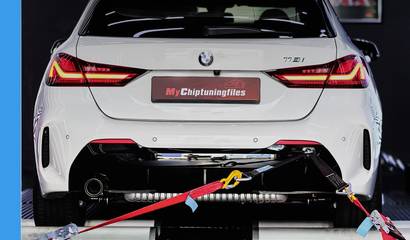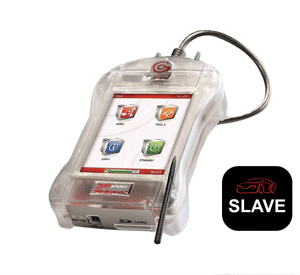Sunday 16 November

So, you want more power, better fuel efficiency, or just a little extra excitement when you step on the gas. You start digging into performance tuning and suddenly, you’re drowning in a sea of technical jargon; ECU remapping, chiptuning, flashing, reprogramming… what does it all mean?
Well, let’s clear that up. If you’re wondering whether ECU remapping or chiptuning is the best choice for your car, you’re in the right place. I’ll break it all down in a way that actually makes sense; no fluff, no confusing tech speak, just straight-up answers.
First Off: What Even is the ECU?
Before we start throwing around terms like remapping and chiptuning, let's talk about what actually gets modified: the ECU (Engine Control Unit).
Think of the ECU as your car’s brain. It controls fuel injection, ignition timing, turbo boost levels (if you have one), throttle response, and a bunch of other things that affect how your car performs. Manufacturers program the ECU with default settings that balance power, fuel economy, and emissions. These settings are conservative; meaning there’s usually extra performance hidden away.
That’s where tuning comes in. By tweaking these settings, we can make your car run more efficiently, deliver more horsepower, or even save fuel.
But here’s where it gets tricky; there’s more than one way to modify the ECU, and that’s where ECU remapping and chiptuning come into play.
ECU Remapping vs. Chiptuning: What’s the Difference?
The goal of both ECU remapping and chiptuning is to modify the settings in your car’s Engine Control Unit (ECU) to improve performance, fuel efficiency, or both. The key difference lies in how the modifications are made.
ECU Remapping: The Modern Method
ECU remapping is the most common tuning method today. It is fast, efficient, and does not require physically opening or modifying the ECU hardware.
With ECU remapping, a tuner connects to the car’s ECU using a laptop and specialized tuning software. They download the existing software, adjust parameters like fuel injection, ignition timing, boost pressure, and throttle response, then upload the new and optimized version back into the ECU.
In most modern cars, this process is done through the OBD (On-Board Diagnostics) port, which is the same port mechanics use for diagnostics and troubleshooting.
Benefits of ECU Remapping:
- Non-invasive – No need to open or remove the ECU; the entire process is done through software.
- Quick and efficient – Most remaps can be completed in under an hour.
- Easily reversible – If needed, the original software can be restored at any time.
- Works on most modern cars – Any car from the last 15-20 years with electronic fuel injection can usually be remapped.
Limitations of ECU Remapping:
- Not all cars support OBD remapping – Some manufacturers have locked or encrypted their ECUs, preventing software modifications through the OBD port.
- May void warranties – Some dealerships will refuse warranty claims if they detect a remap.
- Naturally aspirated engines see limited gains – Without a turbo or supercharger, power increases are usually small.
Chiptuning: The Old-School Method
Before OBD-based ECU remapping became possible, chiptuning was the only way to modify a car’s ECU settings. This process involves physically removing the ECU’s memory chip (EPROM), modifying the data manually, and then soldering the chip back into place.
Since the process originally involved reprogramming a physical chip, the name “chiptuning” stuck, even though modern variations of the method no longer require physical chip replacements.
Even today, chiptuning is still used in some cases where ECU remapping is not possible, such as:
- Older vehicles (pre-2000s) that do not support OBD remapping.
- Certain modern cars with locked or encrypted ECUs, where the only way to modify settings is by physically accessing the ECU.
- Vehicles that require deep-level tuning, where more extensive software modifications are needed.
A more advanced variation of chiptuning, called bench tuning or boot mode tuning, is used when the ECU needs to be physically removed and connected to specialized programming tools.
Benefits of Chiptuning:
- Works on older cars – If a car was built before the early 2000s, chiptuning may be the only option.
- Bypasses locked ECUs – Some manufacturers prevent ECU remapping via OBD, making chiptuning necessary.
- More advanced customization – Some deep tuning modifications require chiptuning rather than OBD remapping.
Limitations of Chiptuning:
- Invasive process – Requires opening the ECU, which can be risky.
- Time-consuming – Unlike OBD remapping, chiptuning can take several hours or even days.
- Harder to reverse – Since it involves modifying the ECU hardware, undoing the changes is more complicated.
Read More: The Journey of Chiptuning: From Basic Remaps to High-Tech ECU Tuning
Which One is Right for Your Car?
Choosing between ECU remapping and chiptuning depends on your vehicle’s age, ECU type, and tuning goals.
ECU Remapping is the Best Choice if:
- Your car was made after the early 2000s and supports OBD tuning.
- You want a fast, simple, and easily reversible performance upgrade.
- You prefer non-invasive tuning that does not require removing or opening the ECU.
- You want the option to restore the original settings in the future.
Chiptuning is Necessary if:
- You have a pre-2000s car that does not support ECU remapping.
- Your car’s ECU is locked or encrypted, preventing OBD tuning.
- You need advanced tuning modifications that OBD remapping cannot achieve.
- You are willing to go through a more complex tuning process for better results.
For most modern vehicles, ECU remapping is the best and most convenient choice. However, if you own an older car or have a heavily secured ECU, chiptuning may be your only option.
How Much Power Can You Gain?
The performance increase from tuning depends on your engine type.
- Turbocharged or supercharged engines – See the biggest gains, often 20-30% more horsepower and torque with just a simple remap. Turbocharged cars, such as the Volkswagen Golf GTI, BMW M-series, and Ford Ecoboost models, benefit the most from tuning.
- Naturally aspirated engines – Gains are smaller, usually around 5-10%, as there is no turbo or supercharger to adjust. However, tuning can still improve throttle response, fuel efficiency, and overall drivability.
- Diesel engines – Respond very well to tuning, often gaining 25-40% more torque, making them much more powerful while also improving fuel efficiency. This is why ECU remapping is extremely popular for diesel trucks and commercial vehicles.
Read More: Understanding ECU Remapping: Benefits and Risks
Is ECU Remapping or Chiptuning Safe?
When done correctly, both ECU remapping and chiptuning are safe. However, improper tuning can lead to serious problems.
A well-executed tune should:
- Increase performance without damaging the engine.
- Maintain safe air-fuel ratios and engine temperatures.
- Improve throttle response and fuel efficiency.
However, a poorly done tune can:
- Cause engine knocking (detonation), which can damage pistons and valves.
- Put excessive strain on the turbo, leading to premature failure.
- Increase fuel consumption if not properly calibrated.
This is why it is critical to choose a reputable tuner. A cheap or poorly done tune can cause more harm than good, leading to expensive engine repairs down the road.
Can You Reverse It?
Yes! One of the best things about ECU remapping (and even chiptuning in some cases) is that it’s not permanent.
If you ever need to return your car to stock; for a dealership visit, warranty claim, or just because you changed your mind; most tuners can restore the original map. Some tuning tools even allow you to switch between stock and tuned modes yourself.
However, some dealerships have advanced tools that can detect if the ECU has been modified, even if you flash it back to stock. If warranty concerns are a big deal for you, check with your tuner before making any changes.
Unlock Peak Performance with MyChiptuningfiles
Want more power, better fuel efficiency, and a smoother drive? MyChiptuningfiles provides high-quality ECU tuning files designed to optimize your car’s performance safely and effectively.
Our experts use advanced tools like WinOLS to fine-tune ECU maps with precision. Every tuning file is custom-made to match your vehicle’s specific needs, ensuring a perfect balance of power and reliability. Whether you need extra horsepower for an exciting ride or improved fuel economy for long-distance travel, we’ve got the right solution for you.
Getting started is simple. Just upload your file, and our professionals will take care of the rest. With years of experience in ECU remapping, we guarantee performance enhancements that are both safe and effective.
The Verdict: Which One Wins?
For most people, ECU remapping is the better choice. It’s fast, safe, and easily reversible. Chiptuning is still relevant, but mainly for older cars or locked ECUs.
At the end of the day, both methods achieve the same goal; getting the most out of your engine. The right choice just depends on your car’s make, model, and what kind of performance boost you’re after.
So, is it worth it? If you love driving and want better performance without spending thousands on mechanical upgrades, absolutely. Just make sure you go to a professional tuner who knows what they’re doing.
Got questions? Thinking about tuning your car? Drop a comment below; I’d love to hear what you’re working on!
news.related_news
Chiptuning tools
Whether you own a car, truck or tractor: we have the best equipment and software for tuning your petrol and diesel engine. With our chiptuning tools it is possible to easily read out the original engine software of your vehicle and upload it to our website. And then it's up to us to provide you with high-quality and customized chip tuning files. Curious about our range of chiptuning tools? Check it out via the button below!









